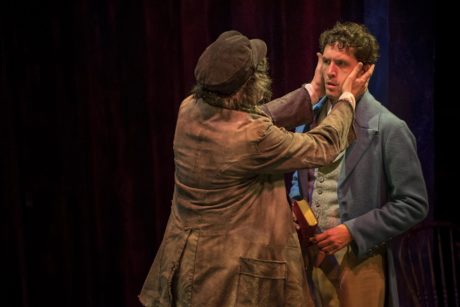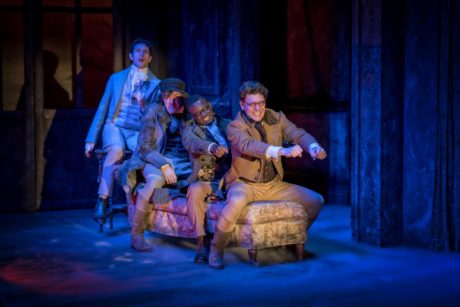Everyman Theatre (“Everyman”) continues its 2016/2017 season with an ambitious production: Charles Dickens’ Great Expectations. A work of literature epic in scope and scale, the most notable challenge in this version of the piece – as adapted for the stage by Gale Childs Daly – is that a cast of merely six actors is tasked with performing a whopping 35 different characters. I never doubted the company could pull it off, though. Having attended several seasons of excellent theater there, I always arrive at Everyman with, well, great expectations.
Great Expectations begins in 1812 England and spans 34 years in the eventful life of an orphan named Pip. At the start of the play, Pip is being raised by his adult sister, the truculent Mrs. Joe, and her husband, a blacksmith named Joe Gargery, who is as gentle and kind-hearted as his wife is resentful and abusive. After meeting a bitter, wealthy woman named Miss Havisham and her adopted daughter, Estella, Pip becomes aware for the first time that he is poor and unrefined. He dreams of becoming a proper gentleman and, with the help of a mysterious benefactor, he does just that. Along the way, he experiences danger, tragedy, scandal, love, heartbreak, and joy.

As the protagonist, Pip, Drew Kopas is the only actor in Great Expectations who plays a single role. Pip’s life is the centerpiece of the show; he recounts his story in a combination of adult-voiced recollections and in-the-moment scenes in which he interacts with the other characters. Kopas is not only convincing as the guileless 7-year-old orphan, but also as the urbane London gentleman that child grows up to be.
Utilizing an impressive array of skills, Kopas transforms onstage as Pip ages and becomes more genteel. His posture, gestures, facial expressions and walk evolve as Pip grows from a timid, abused child into a confident gentleman. Kopas changes how Pip sounds, his voice deepening and his accent and manner of speaking becoming more polished throughout his character’s transformation. Kopas’ work in Great Expectations is the best work I’ve seen him do.
The remaining five actors, each credited in the program as a numbered “Narrator,” portray the other 34 characters in this production. This requires them to make split-second changes not only in costume, but in every aspect of what makes a character identifiable. They do not enjoy the luxury of time that Kopas has to grow and develop gradually throughout the play. In fact, there are numerous times when the same actor will play multiple characters within the span of a single scene. This dexterous display of talent is superb. Thanks to their capable acting and myriad physical and vocal changes, I did not once struggle to distinguish which character any of these actors was portraying at a particular moment.
Everyman Resident Company Member Bruce Randolph Nelson, Narrator #1, plays nine distinct roles in this show. Abel Magwitch, a criminal who has escaped a prison ship, is desperate and scary. Nelson presents his character with a posture uneven due to a shoulder hump and partly hobbled by a leg iron; as he threatens 7-year-old Pip, his accent and vocabulary reveal Magwitch as a man sentenced by his class to a life of crime. Nelson portrays Mr. Jaggers, on the other hand, as a well-spoken – if condescending – attorney whose wealth and station are a world away from Magwitch’s. The fluidity with which Nelson can move between characters and still have each feel fully-developed and real is a pleasure to watch.
Among the 10 characters Franchelle Stewart Dorn, Narrator #3, portrays, Dorn shines brightest as Miss Havisham. Adeptly playing this character as equal parts pernicious and pitiable, Dorn conveys Havisham’s cruel behavior, but shows that it was born from tragedy. Dorn delivers an emotionally compelling performance that unveils Havisham as a complete person instead and not merely a one-dimensional embodiment of bitterness. Dorn’s portrayal of the caustic Mrs. Joe is also notable. With a working-class accent and excellent physical acting, Dorn exposes Mrs. Joe as a woman who fancies herself an angelic martyr, but who is, in fact, a big bully.

Brit Herring, Narrator #5, also plays numerous characters exceptionally well. Herring is charming as the kind, self-sacrificing blacksmith, Joe Gargery. He masterfully portrays Joe’s optimism, enthusiasm, and generosity with a broad smile and open body language that reads like he is greeting the world with a hearty handshake. While Herring’s Joe leads with his warm heart, his Bentley Drummle moves about arrogantly with a handkerchief in hand, usually brought up to his face as if to protect himself from the stench of his inferiors – which would be basically everyone. He is self-serving and self-important, the opposite of Joe in every way. Herring’s ability to switch between such dissimilar characters at the breakneck pace of this production is impressive.
Narrator #2, Gerrad Alex Taylor, is a Resident Company Member at another fine Baltimore institution, the Chesapeake Shakespeare Company. The best of his varied roles in Great Expectations include Pip’s roommate/best friend Herbert Pocket and Mr. Wopsle, a clerk from Pip’s village who goes to London to pursue acting (to entertainingly comic effect). Taylor’s performance as Pocket is polite and proper, with excellent posture, dignified speech, and a gentleman’s accent. His Wopsle, on the other hand, is not so polished or cosmopolitan. The scene where Pip attends Wopsle’s production of Hamlet is wonderful. Taylor playing a parish clerk who is, in turn, playing the ill-fated Prince of Denmark, is hilarious.
Rounding out the cast as Narrator #4, among other characters, is Elizabeth Anne Jernigan. Her versatility in this show is commendable. Noteworthy among her characters are the haughty Estella, the helpful girl-next-door, Biddy, and the dastardly criminal Compeyson. She also portrays an outrageously over-the-top Ophelia, which I loved. I last saw Jernigan perform years ago, while she was still a student at Catholic University. I was impressed by her talent back then and she has clearly continued to hone her craft in her post-college career. I hope to see a lot more of her work in the future.

I also look forward to seeing more of Scenic Designer Yu-Hsuan Chen’s sets. The one she conceived for this Dickens classic is a masterpiece. Immense – extending floor-to-ceiling, wall-to-wall, and then some – it is packed with texture and detail that suits every scene and location in the production. Moldering, water-damaged wall coverings, peeling paint, and threadbare furniture create a bleak, melancholy atmosphere. It embodies Pip’s description of Miss Havisham’s house, in which “everything within my view which ought to be white, had been white long ago, and had lost its luster.” Long unused chandeliers and decaying finery attest that all the living that took place in this once-great home had ceased decades before, despite its continued habitation. This set is so aesthetic and expressive that still photos from the production resemble the rich paintings of Baroque artists.
First-rate lighting design by Stephen Quandt makes the most of the rich textures of the set. Quandt skillfully uses his medium to visibly alter the appearance of the stage. In concert with the excellent soundscape created by Sound Designer/Composer Fabian Obispo, Quandt’s lighting design successfully evokes locations as disparate as marshes in a rainstorm, a blacksmith’s workshop, a London attorney’s office, and a spooky cemetery.
Kudos are due to Costume Designer David Burdick for devising a way to outfit six actors playing 35 roles with split-second costume changes, many of which occur onstage. Burdick designed period-appropriate clothing that could be altered significantly with the quick addition or removal of key elements. Removing an apron, wrapping up in a long coat, donning a distinctive hat, adding an Elizabethan collar… each of these relatively small changes, when made to a flexible and carefully-considered costume base, make it possible for the actors to change identity in moments.
Lauded for his extensive success directing opera, Director Tazewell Thompson was an ideal choice to lead this talented cast and artistic team. Pulling together the many parts of this sizable production and forging them into a fluid, fast-paced whole was a formidable challenge performed expertly by Thompson.
Doomed by years on middle school English syllabi, it is easy to forget what an intricate and meaningful story Dickens wrote in the novel Great Expectations. It deals with issues of class, wealth, the sources of happiness and the timeless question of whether a person, at heart, can change. Everyman Theatre’s production of Great Expectations brings this classic piece of literature to life. With its breathtaking set, fast pace, and exceptional work by a team of top-notch actors and designers, Great Expectations is a production people will remember for some time. Make sure you’re one of the lucky people who saw it, not one of those who regrets having missed it.
Running Time: Approximately two hours and 30 minutes, including an intermission.
Great Expectations plays through March 5, 2017 at Everyman Theatre – 315 West Fayette Street, in Baltimore. For tickets, visit the box office or go online.
Caution: This production contains haze and fog effects.
Parking: Available across the street at the Atrium Garage. It costs $11.00.
LINK:
Review: Charles Dickens’ ‘Great Expectations’ at Everyman Theatre by Wendi Winters.





